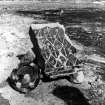Dunmore Pottery
Pottery Works (19th Century)
Site Name Dunmore Pottery
Classification Pottery Works (19th Century)
Alternative Name(s) 5 Fairfields, 6 Fairfields
Canmore ID 46855
Site Number NS88NE 44
NGR NS 87272 88388
Datum OSGB36 - NGR
Permalink http://canmore.org.uk/site/46855
- Council Falkirk
- Parish Airth
- Former Region Central
- Former District Falkirk
- Former County Stirlingshire
NS88NE 44 87272 88388
Annotated as Pottery, one unroofed building, seven roofed buildings and two enclosures are depicted on the 1st edition of the OS 6-inch map (Stirlingshire 1865, sheet xviii). One unroofed building and one roofed building are shown on the current edition of the OS 1:10000 map (1988).
Information from RCAHMS (SAH) 10 May 2000
NS 8728 8838 During the summer of 2000, redevelopment took place on the site of the former Dunmore Pottery near Airth (NMRS NS88NE 44). A watching brief was maintained, but nothing of note emerged. However, the developer also excavated an additional area in order to accommodate a large septic tank and associated sewerage pipes, and thus cut through the immediate location of erstwhile pottery production. The opportunity was taken to gather some material, though because of the highly disturbed state of the ground, stratigraphy could play no part in the investigation.
A substantial quantity of interesting sherds were collected, but because of the circumstances of their retrieval, none of them - except those in bisc condition - can be definitely regarded as having been made on site. Country redware accounts for a good proportion of the assemblage, with both creaming bowls and pickling jars being well represented.
Also strongly represented are redware Rockingham teapots. Many pieces of bisc were recovered, and they reveal the making techniques quite clearly. The remainder of the assemblage consists mostly of white earthenware, caneware and stoneware. The big surprise is the dearth of typical Dunmore Ware, and only two sherds were recovered.
The most exciting find was a deposit of slip-banded ware. Kiln furniture was also discovered in some abundance.
The spoil tips were littered with freshly exposed plaster moulds, some with their 'male' and 'female' sockets still in place, and though most had been reduced to featureless lumps, some small areas of moulded patterning had survived. A quantity of industrial debris includes pieces of kiln brick with glaze accretions.
These sherds, together with a report on their significance, have been lodged with Falkirk Council Museum Services.
Fuller report lodged with the NMRS.
G Cruickshank 2001.
This site has only been partially upgraded for SCRAN. For full details, please consult the Architecture Catalogues for Falkirk District.
February 1998
Publication Account (1986)
This small pottery manufactured tiles and domestic ware from the local red clay of Dunmore Moss and from the superior clays of Devon and Cornwall. It originated in the early 19th century, but most of the surviving remains appear to date from the period after about 1860, when the pottery was acquired by Peter Gardiner of Alloa. The remains include the ruins of a brick-built bottle-kiln about 16ft 9in (5.11m) in diameter, which was badly damaged in a gale in January 1974 and subsequently demolished. There is a range of single-storeyed and pantile-roofed workers' cottages in a nearby field , and the manager's house stands a short distance to the SE of the kiln. A room in the E wing of this house has a decorative tiled interior, the tiles at one time covering the ceiling and much of the walls, as well as the fireplace and doorway. The tiles are of a highly colourful faience type, typical of Dunmore ware, and one of the ceiling plaques is dated 1887. There was a decoratively tiled lavatory in an outbuilding SE of the house, and it is believed that both these schemes were carried out in honour of a visit to the pottery by the Prince of Wales, later Edward VII.
Information from ‘Monuments of Industry: An Illustrated Historical Record’, (1986).
Strip And Record (7 April 2009 - 27 April 2009)
NS 8726 8841 A monitored topsoil strip on the site of the former Dunmore pottery works in April 2009 identified three pits, two of which contained post-medieval pottery. The pottery from one of the pits mainly consisted of green-glazed Post-medieval Oxidised and Reduced Wares (SPMO, SPMR). This material is thought to date to the 15th to 18th century and probably represents some of the earliest material produced on the site. The material from the second pit was later, probably dating to the late 18th/19th century. Previous work on the site
produced wasters of both ‘country pottery’ redwares and whitewares (Cruickshank DES 2001), but does not appear to have recovered any evidence for earlier pottery production. This assemblage, although small, is very important for the study of post-medieval ceramics in Scotland because it is only the second production site of SPMO/R to be located, the other being at Throsk, Stirlingshire.
Archive: Falkirk Council SMR and RCAHMS
Funder: Mr Tom Smith
Magnus Kirby and Sue Anderson (CFA Archaeology Ltd) May 2009.
OASIS ID: cfaarcha1-59214




























































































































